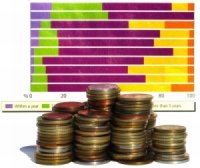Journal Entry for Shares Issued

Question:
Make a journal entry for the following (assume that this occurred in the second half of 2009):a) Issued additional shares for 1,200 in cash.
Answer:
The journal entry would be as follows:Dr Bank....................1,200
Cr Share Capital....................1,200
Because the shares are issued for cash we have more cash, and since cash is an asset which occurs on the left side, we debit this.
The shares issued is a type of capital account specifically for a company. A share is actually a small piece of ownership of a company (in a company you can have many owners and each owner owns shares in the company).
We have more shares issued - more capital - and since capital is owner's equity and occurs on the right side, we credit this account.
Note that the account name "Share Capital" could also be called "Common Stock." Stock means shares and common stock simply means the normal type of shares issued (there can be a few types of shares besides just regular ones).
Par Value and Share Premium
 Note that shares can have something called a par value, which is the official or original face value of each share. But they can be issued (sold) for much more than its par
Note that shares can have something called a par value, which is the official or original face value of each share. But they can be issued (sold) for much more than its par When shares are issued at greater than par value, we have a special journal entry:
Dr Bank
Cr Share Capital (for the par value)
Cr Share Premium (for the amount above the par value)
For example, Supershoes Limited issues 1 million shares with a par value of $3 for $5 million. The journal entry would be:
Dr Bank....................5,000,000
Cr Share Capital....................3,000,000
Cr Share Premium....................2,000,000
Both the "share capital" and "share premium" accounts are capital accounts and together add up to the total value of share capital.
Note that the account name "Share Premium" is also sometimes called "Paid in Capital in Excess of Par Value" or "Additional Paid-in Capital."
In some cases you can have shares with no par value. In that case you would do an entry like the first one above, with no "Share Premium."
In rare cases shares can also be issued at a discount to the par value (less than the par value).
Hope that all makes sense! Good luck!
Best,
Michael Celender
Founder of Accounting Basics for Students
Related Questions & Tutorials:
- Journal Entry: Issuing Shares for Multiple Assets
- Company Trial Balance and Financial Statements Question (full exercise and solutions)
- Owner's Equity Journal Entry (Capital Investment)
Click here for more Basic Accounting Questions and Answers
Comments for Journal Entry for Shares Issued
|
||
|
||
© Copyright 2009-2021 Michael Celender. All Rights Reserved.
Click here for Privacy Policy.



